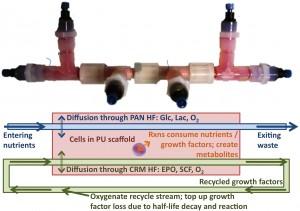
Project Lead: Ruth Misener
The Imperial College London Biological Systems Engineering Laboratory recently developed a novel, biomimetic, cost-effective three-dimensional hollow fibre bioreactor for growing healthy red blood cells ex vivo (Panoskaltsis et al., 2012). This bioreactor recapitulates architectural and functional properties of erythrocyte formation and thereby reduces the need for expensive growth factors by more than an order of magnitude. Individual experiments to empirically improve the bioreactor are intensive, so we propose global superstructure optimisation for bioreactor design. Our approach integrates topological design choices with operating conditions. Design choices include: number of parallelised bioreactors; number and type of hollow fibres; size and aspect ratio. Operating conditions are: feed concentrations; flowrate through the reactor. We quantitatively demonstrate, for the first time, the potential for ex vivo red blood cell production to compete openly against the transfusion market for rare blood.
Collaborators
- Prof Sakis Mantalaris, Mark Allenby (Experimental bioreactor design)
- Dr Nicki Panoskaltsis (Haematology)
- Prof Stratos Pistikopoulos, Dr María Fuentes Garí (Mathematical Modelling)
- Dr Eirini Velliou (Bioprocessing)
Poster for a General, Technically-Educated Audience
- Making and Healing Blood: An Engineer’s Approach (poster created for the 2013 RAEng Annual Research Forum)


